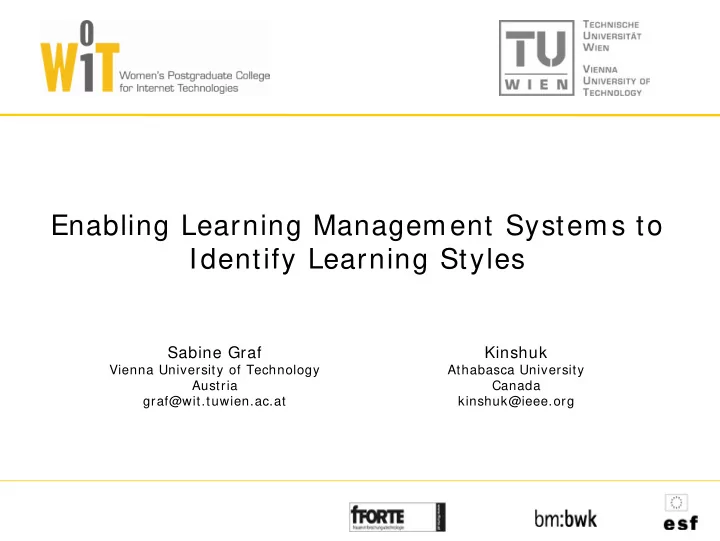

Enabling Learning Management Systems to Identify Learning Styles Sabine Graf Kinshuk Vienna University of Technology Athabasca University Austria Canada graf@wit.tuwien.ac.at kinshuk@ieee.org
Motivation � Learning Management Systems (LMS) are commonly used but they provide only little and in the most cases no adaptivity � Learners have different needs � Incorporating these needs increase the learning progress, leads to better performance, and makes learning easier � Requirement for adaptivity: needs have to be known first � Comprehensive questionnaires � Identification from the behavior of students during a course 2
Research Question How to enable LMS to identify learning styles? � Developed an approach that identifies learning styles according to the behavior of students in LMS � Identified patterns of behavior � Implemented a tool that extracts data from LMS database and calculates the learning styles � Which requirements are necessary to provide all recommended information? � Practical example (Moodle) 3
Felder-Silverman Learning Style Model � Richard M. Felder and Linda K. Silverman, 1988 � Each learner has a preference on each of the four dimensions � Dimensions: � Active – Reflective learning by doing – learning by thinking things through learning by discussing & group work – work alone � Sensing – Intuitive concrete material – abstract material more practical – more innovative and creative patient and careful/ not patient and careful with details standard procedures – challenges � Visual – Verbal learning from pictures – learning from words � Sequential – Global learn in linear steps – learn in large leaps good in using partial knowledge – need „big picture“ interested in details – interested in the overview 4
Patterns of Behavior � Felder and Silverman describe how learners with specific preferences act in learning situations � Mapped the behavior to LMS � Approach for identifying learning style should be applicable for LMS in general � Only commonly used features are considered: � Content objects � Examples Felder-Silverman Commonly used Learning Style features in LMS � Tests Model (self-assessment and marked) � Exercises � Communication tools Patterns of (forum, chat) behavior 5
Patterns of Behavior � Content objects � Time student spent on content objects � Time student spent on content objects including graphics � Number of visits on outlines � Time spent on outlines � Examples � Number of visits � Time spent on examples � Tests (self-assessment and marked tests) � Results � Number of revisions before submission � Time spent on the test � Self-assessment tests � Number of tests performed � Results on specific kinds of questions (facts/ concepts, detail/ overview, graphics/ text) 6
Patterns of Behavior � Exercises � Number of visits � Time students spent on exercises � Communication tools: forum, chat � Number of visits � Number of postings � Navigation � Number of times, students skip learning objects � Number of visits of the course content page � Time students spent on the course overview page 7
Patterns of Behavior Active/Reflective Sensing/Intuitive Visual/Verbal Sequential/Global Visits_forum (act) Correct_facts/concepts (sen) Visits_forum (ver) Correct_detail/overview (seq) Postings_forum (act) Revisions_marked tests (sen) Postings_forum (ver) Performance_marked tests (seq) Visits_chat (act) Revisions_SA tests (sen) Visits_chat (ver) Performance_SA tests (seq) Postings_chat (act) Duration_marked tests (sen) Postings_chat (ver) Visits_outline (glo) Visits_exercise (act) Duration_SA tests (sen) Time_graphics (vis) Time_outline (glo) Time_exercises (act) Visits_exercises (int) Correct_graphics (vis) Skips_learning objects (glo) Time_examples (ref) Time_exercises (int) Visits_overview page (glo) Time_content objects (ref) Visits_SA tests (sen) Time_overview page (glo) Visits_examples (sen) Time_examples (sen) 8
Tool Architecture � Tool can be applied for LMS in general � Each LMS has a different database schema � Maybe not all features are used or data for patterns can be tracked � Architecture: 9
Requirements Requirements for providing all recommended information in LMS: 1. Features have to be available in LMS 2. Behavior have to be tracked by the LMS 3. Authors have to include the respective features in their courses 10
Extensions regarding incorporating all features � Moodle incorporates many features, only some are of particular interest: � Resources � Quiz � Forum � Chat � Learning material regarding all proposed features can be created � But learning material also has to be distinguished regarding all proposed features � Additional meta-data 11
Extensions regarding incorporating all features Resources: � Resources can be used to present content object, an outline of a chapter or an example � Performed modifications: � Meta-data for distinguishing between content object, outline, and examples � Meta-data about whether graphics are included in content objects 12
Extensions regarding incorporating all features Quiz: � Quizzes can represent self-assessment tests, marked tests, and exercises � Performed modifications: � Meta-data for distinguishing between self-assessment test, marked test, and exercise � Meta-data for specifying each question (facts/ concepts, details/ overview, graphics/ text) No extensions regarding forum and chat 13
Extensions regarding tracking activities � Moodle provides comprehensive tracking functions � For each action a learner performs, an entry is done in a log table (including user-id, action, time, … ) � Only one extension is necessary: � Revision of answers to self-assessment or marked tests � Store each answer � Sequence of keys for textual answers (attention to delete and backspace key) � Information about how often students are revising their answers 14
Conclusion and Future Work � Proposed an approach that enables LMS to identify learning styles based on the behaviour of students � students do not have to fill out comprehensive questionnaires � Presented a tool that extracts relevant data from the database of the LMS and calculates leanring styles � Showed how Moodle can be extended to deliver all recommended data (use the tool more effectively) 15
Conclusion and Future Work � Extended version of Moodle has been used for teaching XML at university � Second course about object-oriented modelling will be held next semester � Future work will deal with analysing the gathered data and comparing the results from the tool with the results from ILS � Future work will deal with incorporating partial information in the calculation process 16
Recommend
More recommend